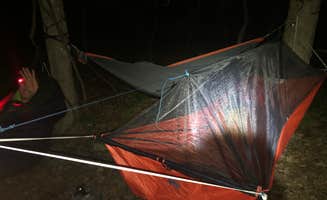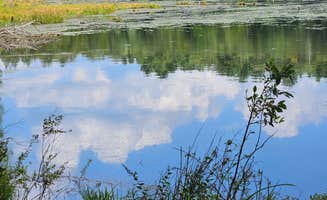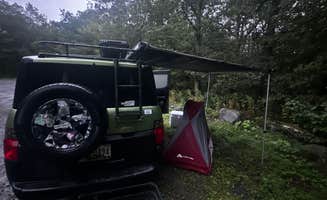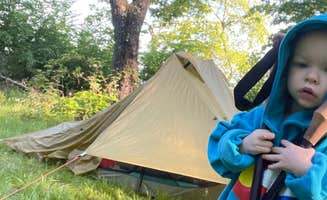Primitive camping near Tuxedo Park, New York provides access to the eastern Catskill foothills and Hudson Valley terrain. The region features hardwood forests with elevations ranging from 400 to 1,000 feet, experiencing moderate rainfall and occasional summer fog. Dispersed camping options typically require permits through the New York Department of Environmental Conservation and follow strict Leave No Trace protocols.
What to do
Hiking extensive trail networks: The 900-acre forest at Taconic Hereford Multiple Use Park connects to additional protected lands with numerous trails. A visitor explains, "There is plenty of trails to explore and wildlife to enjoy, especially since these over 900 acres also back up to another huge plot of protected forests."
Lakeside relaxation: Primitive sites at Hickok Brook offer water access for swimming and fishing. Camper Gregg notes, "Where I originally camped was not a spot, according to Ranger. Had to move next to the lake. Need a permit on NY state land. Contact Rangers office of whatever county."
Section hiking: Backpackers use these sites for multi-day Appalachian Trail segments. "We stayed here during our section hike through the DWG on the AT. There's plenty of space. We camped nearer to others but there are secluded spots too," reports Katharine T. about nearby backcountry options.
What campers like
Off-grid solitude: Dispersed camping areas provide genuine wilderness experiences while remaining accessible. "If you like dispersed camping, like me- this place is good. There are absolutely no amenities whatsoever and barely even a signal here, but it's quiet and off the beaten path," writes Dawn M. about Hemlock Ridge MUA Dispersed.
Accessibility with wilderness feel: Many sites balance remoteness with practical access. "99% off people don't even know this area exists. If you want a quiet piece of beautiful forest to truly rough it and go camping for a few days, then this is what you have been looking for. Less then 10 min drive from town," explains Doc B.
Bear protection infrastructure: Several sites include animal-resistant storage. "Well maintained with bear boxes provided. Good trees for hammocking. We had thought there was a shelter (there isn't) but it was fine. No ground fires," mentions Katharine T. about Appalachian Trail- Designated Backpacker Campsite 2.
What you should know
Water availability challenges: Bring all water needed for your stay. "I gave the site only four stars because there's no water nearby, and the views are only mediocre. Also it's a little on the small and sloped side for tent camping, but I was in a hammock and it was a great place for that," notes Renee Z.
Permit requirements: Many New York state lands require camping permits. "Need a permit on NY state land. Contact Rangers office of whatever county," advises Gregg T. Obtain permits before arrival through county ranger stations.
Limited parking capacity: Most sites have minimal vehicle accommodation. "The parking lot only holds about 4-5 cars, 6 if you park real tight," explains Dawn M. Arrive early during summer weekends to secure parking.
Insect preparation essential: Summer brings significant insect activity. "Bugs are relentless. Many climbers stay there for access to the gunks," warns Cory D. about conditions at dispersed sites.
Tips for camping with families
Cell service considerations: Unlike deep backcountry camping, many sites maintain connectivity. "Finding a suitable place to make camp has the feeling of the wild, with the safety of having full cell service," notes Doc B. about Thunder Swamp Trailhead areas.
Distance planning: Choose campsites based on hiking capabilities. "Stock up on water at the Dunnfield creek natural area, or wait until Sunfish pond. There are lots of signs around Sunfish pond itself that there's no camping allowed," advises Renee Z.
Hammock-friendly locations: Many sites offer better hammock than tent options. "It's a little on the small and sloped side for tent camping, but I was in a hammock and it was a great place for that," shares one camper about sloped terrain.
Tips from RVers
Road condition warnings: Many access roads require high-clearance vehicles. "The road is very rough with huge potholes so good clearance is a must. It's not a good spot for car camping but you could conceivably drive up to the spots and pull off the road to put up a small tent somewhere. Very gorgeous but not rv friendly," cautions Corey about Hickok Brook.
Limited turnaround space: Narrow access roads make large vehicle navigation difficult. "There's only a few spots, and the road is narrow with not much turnaround room, I wouldn't recommend for trailers or RVs," warns Tim M.
Overnight parking alternatives: Some trailheads permit overnight vehicle parking. "Trailhead parking was chill for a night. No trouble. Tons of hiking. Went down Saw Creek trail to a marsh," reports Jason R. about certain designated areas.






